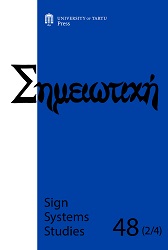Juri Lotman, Gilles Deleuze and their Approaches to Cinema: Points of Intersection
Juri Lotman, Gilles Deleuze and their Approaches to Cinema: Points of Intersection
Author(s): Mihael KonstantinovSubject(s): Semiotics / Semiology, Aesthetics, Contemporary Philosophy, Structuralism and Post-Structuralism, Film / Cinema / Cinematography
Published by: Tartu Ülikooli Kirjastus
Keywords: Deleuze; Lotman; spatio-temporal blocs (relations); nonlinear narrative construction; movement-image; time-image; visual and sound components of cinematographic image; bipolar asymmetry;
Summary/Abstract: Engaging with the methods of studying contemporary digital audiovisual art is a dominant topic in contemporary theories of art. Against this background, the article offers a view onto some aspects of Juri Lotman’s and Gilles Deleuze’s studies on the cinema. As a rule, contemporary studies of digital audiovisual art take place in the context of interdisciplinary studies. One of the methodological principles of such studies consists in adopting a structural and semiotic approach. As of today, this methodological approach to studying audio-visual art is most developed in semiotics of the cinema, which is why in this article visual semiotics in general is viewed through semiotics of the cinema (proceeding from the approach of Juri Lotman). Also, the philosophical understanding of the nature of the cinema offered by Gilles Deleuze has proven fundamental for the study of contemporary audio-visual art. The two authors were contemporaries, but represented different scholarly paradigms: while Juri Lotman was an adherent of structuralism, Gilles Deleuze was a poststructuralist who criticized the structuralist approach. Yet despite this principal difference, both scholars still arrived at similar conclusions as concerns several questions regarding the understanding of the cinema and its very nature. In the present paper I focus on the features of these authors’ approach to spatial and temporal relations in the cinema, audiovisual relations in film as a heterogeneous form of the work of art, virtuality and mythologism in the viewer’s perception of cinema. The differences and similarities in academic approaches to cinema, developed by Lotman and Deleuze, indicate a common direction in the development of the cinema and visual arts theory, which seems relevant for the study of contemporary audio-visual arts.
Journal: Σημειωτκή - Sign Systems Studies
- Issue Year: 48/2020
- Issue No: 2-4
- Page Range: 392-414
- Page Count: 23
- Language: English

